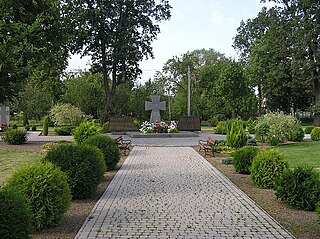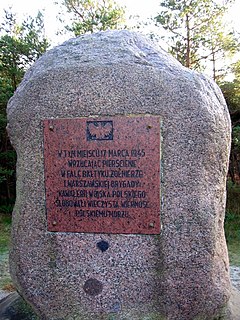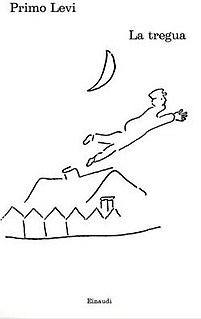 W
WThe Border Agreement between Poland and the USSR of 16 August 1945 established the borders between the Union of Soviet Socialist Republics (USSR) and the Republic of Poland. It was signed by the Provisional Government of National Unity formed by the Polish communists. According to the treaty, Poland officially accepted the ceding its pre-war Eastern territory to the USSR (Kresy) which was decided earlier in Yalta already. Some of the territory along the Curzon line, established by Stalin during the course of the war, was returned to Poland. The treaty also recognised the division of the former German East Prussia and ultimately approved the finalised delimitation line between the Soviet Union and Poland: from the Baltic sea, to the border tripoint with Czechoslovakia in the Carpathians. The agreement entered into force on 5 February 1946.
 W
WThe Kraków pogrom was the first anti-Jewish riot in post World War II Poland, that took place on 11 August 1945 in the Soviet-occupied city of Kraków, Poland. The incident was part of anti-Jewish violence in Poland towards and after the end of World War II. The immediate cause of the pogrom was a blood libel rumour of a ritual murder of Polish children by Jews in the city. A false allegation that a child had been abducted by a Jewish woman had grown to allegations that Jews had killed up to 80 children over the course of weeks. These allegations led to attacks on Jews, as well as some Poles mistaken for Jews, in the Kazimierz quarter, and other parts of the Old Town, and the burning of the Kupa Synagogue. At least one person was killed and an unknown number were injured.
 W
WThe Battle of Kuryłówka, fought between the Polish anti-communist resistance organization, National Military Alliance (NZW) and the Soviet Union's NKVD units, took place on May 7, 1945, in the village of Kuryłówka, southeastern Poland. The battle ended in a victory for the underground Polish forces.
 W
WOn 27 January 1945, Auschwitz concentration camp—a Nazi concentration camp where more than a million people were murdered—was liberated by the Red Army during the Vistula–Oder Offensive. Although most of the prisoners had been forced onto a death march, about 7,000 had been left behind. The Soviet soldiers attempted to help the survivors and were shocked at the scale of Nazi crimes. The date is recognized as International Holocaust Remembrance Day.
 W
WThe Pawłokoma massacre was a massacre on 3 March 1945 of Ukrainians by Polish forces in the village of Pawłokoma 40 km (25 mi) west of Przemyśl. The Polish Home Army (AK) unit was commanded by Lt. Józef Biss and aided by Polish men from surrounding villages. Between 150 to 500 people were executed.
 W
WThe Podgaje massacre refers to the mass murder of Polish People's Armies POWs, who were captured in January 1945 by the Waffen SS. The massacre took place in the town of Podgaje during the night of 31 January, during which approximately 160–210 POWs of the 4th Company, 3rd Infantry Regiment, of the 1st Tadeusz Kościuszko Infantry Division were executed. The murders were most likely committed by the 48th Dutch SS Grenadier regiment and/or by one of the German SS battle groups in the area.
 W
WPoland's Wedding to the Sea was a ceremony meant to symbolize restored Polish access to the Baltic Sea that was lost in 1793 by the Partitions of Poland. It was first performed on 10 February 1920 by General Józef Haller at Puck (Putzig). In the early spring of 1945, following the Polish-Soviet advance into Pomerania, a number of such ceremonies took place in several locations. The most famous 1945 Weddings to the Sea were performed by the soldiers of the Polish Army on 17 March 1945 in Mrzeżyno (Regamünde), and on 18 March in the newly-captured port of Kołobrzeg (Kolberg).
 W
WBiuro Odszkodowań Wojennych BOW - institution established in 1945 by the Presidium of the Council of Ministers in Warsaw to assess the war losses suffered by Poland during the Second World War in 1939-1945. The office dealt with determining and estimating the war losses suffered by the Polish state, as well as private individuals in the field of material and cultural goods, coordinating work related to the compensation and recovery.
 W
WThe Provisional Government of National Unity was a government formed by the decree of the State National Council on 28 June 1945. It was created as a coalition between the Polish Workers' Party and politicians from close political sphere of Stanisław Mikołajczyk, the former prime minister of the Polish government-in-exile based in London.
 W
WThe Przyszowice massacre was a massacre perpetrated by the Red Army against civilian inhabitants of the Polish village of Przyszowice in Upper Silesia during the period January 26 to January 28, 1945. Sources vary on the number of victims, which range from 54 to over 60 – and possibly as many as 69. The Institute of National Remembrance, a Polish organization that carried out research into these events, has declared that the Przyszowice massacre was a crime against humanity.
 W
WThe Raid on Kielce Prison, which took place in Kielce, Poland, in the night of 4/5 August 1945, was carried out by members of anti-Communist resistance, the so-called Cursed soldiers. Their target was a Communist secret services prison, where soldiers of the Home Army, National Armed Forces and other organizations were kept. The raid was carried out by some 200 former Home Army soldiers, led by Antoni Heda and Stefan Bembiński. It resulted in the release of some 350 prisoners.
 W
WThe siege of Danzig was launched by the Red Army against Nazi Germany in March 1945.
 W
WThe Trial of the Sixteen was a staged trial of 16 leaders of the Polish Underground State held by the Soviet authorities in Moscow in 1945. All captives were kidnapped by the NKVD secret service and falsely accused of various forms of 'illegal activity' against the Red Army.
 W
WThe Truce is a 1997 film directed by Francesco Rosi, written by Tonino Guerra, based on Primo Levi's memoir, The Truce. The film deals with Primo Levi's experiences returning to Italy in 1945 after the Red Army liberated the concentration camp at Auschwitz during the Second World War. This was Rosi's final film before his death in 2015.
 W
WThe Truce, titled The Reawakening in the US, is a book by the Italian author Primo Levi. It is the sequel to If This Is a Man and describes the author's experiences from the liberation of Auschwitz (Monowitz), which was a concentration camp, until he reaches home in Turin, Italy, after a long journey. He describes the situation in different displaced persons camps after the Second World War.
 W
WThe Vistula–Oder offensive was a Red Army operation on the Eastern Front in the European theatre of World War II in January 1945. The army made a major advance into German-held territory, capturing Kraków, Warsaw and Poznań. The Red Army had built up their strength around a number of key bridgeheads, with two fronts commanded by Marshal Georgy Zhukov and Marshal Ivan Konev. Against them, the German Army Group A, led by Colonel-General Josef Harpe, was outnumbered five to one. Within days, German commandants evacuated the concentration camps, sending the prisoners on their death marches to the west, where ethnic Germans also started fleeing. In a little over two weeks, the Red Army had advanced 300 miles (483 km) from the Vistula to the Oder, only 43 miles (69 km) from Berlin, which was undefended. However, Zhukov called a halt, owing to continued German resistance on his northern flank (Pomerania), and the advance on Berlin had to be delayed until April.